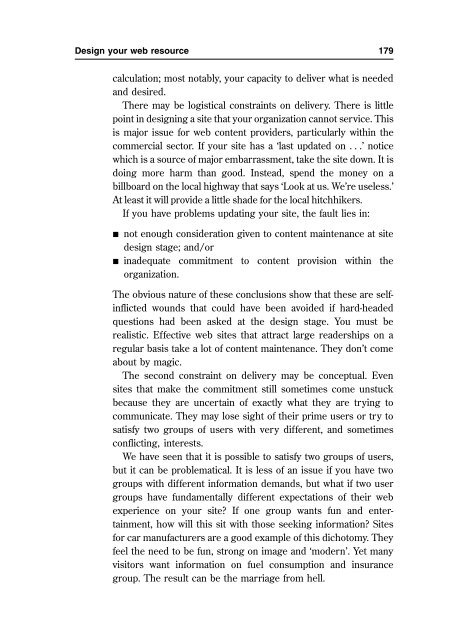1What is online journalism? - Ayo Menulis FISIP UAJY
1What is online journalism? - Ayo Menulis FISIP UAJY
1What is online journalism? - Ayo Menulis FISIP UAJY
You also want an ePaper? Increase the reach of your titles
YUMPU automatically turns print PDFs into web optimized ePapers that Google loves.
Design your web resource 179<br />
calculation; most notably, your capacity to deliver what <strong>is</strong> needed<br />
and desired.<br />
There may be log<strong>is</strong>tical constraints on delivery. There <strong>is</strong> little<br />
point in designing a site that your organization cannot service. Th<strong>is</strong><br />
<strong>is</strong> major <strong>is</strong>sue for web content providers, particularly within the<br />
commercial sector. If your site has a ‘last updated on . . .’ notice<br />
which <strong>is</strong> a source of major embarrassment, take the site down. It <strong>is</strong><br />
doing more harm than good. Instead, spend the money on a<br />
billboard on the local highway that says ‘Look at us. We’re useless.’<br />
At least it will provide a little shade for the local hitchhikers.<br />
If you have problems updating your site, the fault lies in:<br />
not enough consideration given to content maintenance at site<br />
design stage; and/or<br />
inadequate commitment to content prov<strong>is</strong>ion within the<br />
organization.<br />
The obvious nature of these conclusions show that these are selfinflicted<br />
wounds that could have been avoided if hard-headed<br />
questions had been asked at the design stage. You must be<br />
real<strong>is</strong>tic. Effective web sites that attract large readerships on a<br />
regular bas<strong>is</strong> take a lot of content maintenance. They don’t come<br />
about by magic.<br />
The second constraint on delivery may be conceptual. Even<br />
sites that make the commitment still sometimes come unstuck<br />
because they are uncertain of exactly what they are trying to<br />
communicate. They may lose sight of their prime users or try to<br />
sat<strong>is</strong>fy two groups of users with very different, and sometimes<br />
conflicting, interests.<br />
We have seen that it <strong>is</strong> possible to sat<strong>is</strong>fy two groups of users,<br />
but it can be problematical. It <strong>is</strong> less of an <strong>is</strong>sue if you have two<br />
groups with different information demands, but what if two user<br />
groups have fundamentally different expectations of their web<br />
experience on your site? If one group wants fun and entertainment,<br />
how will th<strong>is</strong> sit with those seeking information? Sites<br />
for car manufacturers are a good example of th<strong>is</strong> dichotomy. They<br />
feel the need to be fun, strong on image and ‘modern’. Yet many<br />
v<strong>is</strong>itors want information on fuel consumption and insurance<br />
group. The result can be the marriage from hell.
















